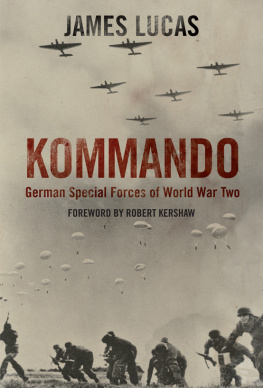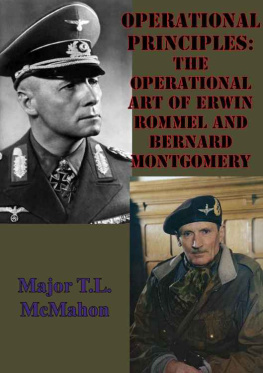
This edition is published by PICKLE PARTNERS PUBLISHINGwww.picklepartnerspublishing.com
To join our mailing list for new titles or for issues with our books picklepublishing@gmail.com
Or on Facebook
Text originally published in 1963 under the same title.
Pickle Partners Publishing 2015, all rights reserved. No part of this publication may be reproduced, stored in a retrieval system or transmitted by any means, electrical, mechanical or otherwise without the written permission of the copyright holder.
Publishers Note
Although in most cases we have retained the Authors original spelling and grammar to authentically reproduce the work of the Author and the original intent of such material, some additional notes and clarifications have been added for the modern readers benefit.
We have also made every effort to include all maps and illustrations of the original edition the limitations of formatting do not allow of including larger maps, we will upload as many of these maps as possible.
BASE DEFENSE AT THE SPECIAL FORCES FORWARD OPERATIONAL BASES
By
MAJ Curtis W. Hubbard, USA
TABLE OF CONTENTS
Contents
TABLE OF CONTENTS
REQUEST FROM THE PUBLISHER
ABSTRACT
Special Forces forward operational bases (FOB) are essential for mission and contingency planning as well as for the preparation, infiltration and exfiltration of Operational Detachment Alphas (ODA). Therefore, the defense of this command and control headquarters is critical for preserving combat power and synchronizing military actions in a theater of operations. Because the enemy has the capability of projecting forces with the objective of disrupting US military operations, FOBs have become likely targets.
According to SF doctrine, FOBs should be located in secure areas with MP or host-nation personnel providing the bulk of the security force. Although this situation is preferable, it is by no means assured. FOBs should be able to provide their own security in the event other forces are not available or when rapid deployment restricts the flow of conventional forces into a theater of operations. After-action review results from the Joint Readiness Training Center demonstrate that many SF battalions are not prepared to execute base defense tasks without the assistance of other forces. Many SF commanders do not consider base defense a mission essential task and the result is a lack of training by many of their personnel.
This study analyzes joint and SF doctrine, observations from the field, and the effects of the contemporary operating environment to identify weaknesses in the readiness of SF battalions. This project attempts to answer three major questions that are the basis for the research. 1) With the emergence of an asymmetrical threat in the contemporary operating environment, does current doctrine adequately and realistically address base defense measures at the FOB? 2) Can SF commanders assume that attachments from other units will be available to defend FOBs? 3) Has the nature of the threat changed significantly enough to alter current thinking? This study leads to the conclusions that SF should make base defense a priority, modify its doctrine, implement new training strategies, and procure base defense equipment.
ACKNOWLEDGMENTS
First, I must thank my wife Michelle, my brother Glenn, and my mother Glenda for their love and supportyou are the best. During every phase of my life I have been blessed with amazing friends, both in the US and abroad. There are too many to list here, but suffice to say that all of those from my hometown in Boone, NC, college in Miami, FL, and those I have met in the army and on visits overseas, have made life rewarding and worthwhile; for that I am eternally grateful. I would like to thank my committee, LTC (Ret) Occhiuzzo, LTC (Ret) Babb, and Dr. Willbanks (LTC, Ret) for their guidance and professionalism during the course of this project. Thanks also to Carolyn, Sylvia, Glenn, Glenda, Michelle, and Helen Davis for support and proofreading help while attempting to understand SF operations and our associated acronyms.
Thank you to my previous battalion commanders, LTC Zeigler and COL Ruggley, for providing guidance and support without micromanagement during my commands. To the men of 3rd Special Forces Group (Airborne)you are the unsung heroes of SF.
And to my Dad who is my true North seeking arrow.
LIST OF TABLES
Table
Threat Levels and Response Mechanisms
ACRONYMS
AAR after-action review
AOarea of operations
AOBadvanced operational base
AORarea of responsibility
ARSOFArmy Special Operations Forces
ARTEPArmy Training and Evaluation Program
BDOCbase defense operations center
BCOCbase cluster operations center
C2command and control
CAcivil affairs
CHECOContemporary Historical Examination of Current Operations
CICounterintelligence
CINCcommander in chief
COGcenter of gravity
DODDepartment of Defense
FMfield manual
FOBforward operational base
FSOPfield standing operating procedure
FTXfield training exercise
HHCheadquarters and headquarters company
HSCheadquarters and support company
ISOFACisolation facility
JFCjoint forces command
JRACjoint rear area coordinator
JRTCJoint Readiness Training Center
JSOAjoint Special Operations area
JSOTFjoint Special Operations task force
JTFjoint task force
QRFquick reaction force
MASCALmass-casualty
MEDEVACmedical evacuation
METLmission-essential task list
MImilitary intelligence
MIDmilitary intelligence detachment
MOOTWmilitary operations other than war
MPmilitary police
MTOEmodified table of organization and equipment
MTWmajor theater of war
NCOnon-commissioned officer
OCobserver-controller
ODAoperational detachment alpha
OPCENoperations center
OPFORopposing forces
PMEpeacetime military engagement
PZpick-up zone
RAOCrear area operations center
ROErules of engagement
RTOCrear tactical operations center
SFSpecial Forces
SFG(A)Special Forces group (airborne)
SFOBSpecial Forces operational base
SIGCENsignal center
SJAstaff judge advocate
SOSpecial Operations
SOFspecial operations forces
SOGsergeant of the guard
SOPstanding operating procedure
SOSCOMSpecial Operations Support Command
SPTCENsupport center
SSCsmaller-scale contingency
TAPThe Army Plan
TCFtactical combat force
THPtake home packet
THREATCONthreat condition
TTPtactics, techniques, and procedures
USUnited States
UWunconventional warfare
XOexecutive officer
CHAPTER 1 INTRODUCTION
Special Forces Base Defense
Although the operating environment has changed since the fall of the Berlin Wall in 1989, US Army Special Forces (SF) doctrine associated with base defense at the forward operational base (FOB) has not adapted. SF doctrine is vague and does not provide guidance to deployed battalions that must be able to execute missions both independently or as part of a joint task force. It is vital that the force implements creative solutions to these doctrinal shortcomings in order to prevent future casualties at SF FOBs.












